ITALY - GIACOMO ROCCON, BARBARA TABONI 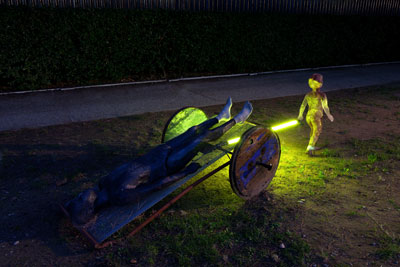
The world is full of carts, with broken axles nailed to the ashes of the floor. Just like the crystallized fossils, in the cinematographic mechanism, which does not foresee any continuity with a conclusion. Winged carts, Apolline, drawn by white swans. Which most of the time however carry white bent men, wrapped in faded rags. Or some laden with light fabric for the making of soft fine clothes to lie in.
H491 is the first sculptural work realized together by Barbara Taboni e Giacomo Roccon. Here is a new cart, a war cart, and crystals like knives.
Mathew, 18:22 - After numerous forgiveness, seventy times seven, the measurement of man in history, of this man in this story, is at it’s peak, Therefore time to refocus on the small crystal. And perhaps Christ was a Crystal?
H491 does not present an indigo child, intent on plunging itself into the flow of the human being with its load of historical furnishings. Rather it deals with a radiant open craft, a new war-like critical device. Piloted by, apart from the last patience, by a crystal child, hydrogenous raw materials transformed into hydrogenous ends.
The iridescent child, facetted tungsten prism, translucent daimon body, breaks the space, widening it and radiating a spectrum of iridescent, underwater colours. They push the stone cart along, on which a man is lying with his head pushed backwards. Burnt, his face a carbon mask. The grey heavy felt uniform in perfect order.
The clothes and posture are those of the perfect ashen Official.
The child, again is a motor, a star, a positive tool, a reactor, producer of high energy.
After the nuclear fusion, the compound is thrown into the mould – the form of the device for critical interaction. It crystallizes, the resinous lava runs, and becomes part of the cart. It fills the wheels. The small craft is in agreement with the blades of light, gently sharpened ablators of decomposition have led to the climax of the chemical-gold renewal.
Text by Gianluca D'incà Levis
ITALY - OTTAVIO PINARELLO
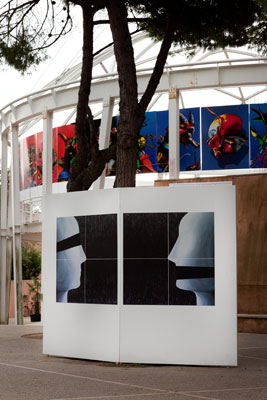
Pinarello, with the symbolic use of the stylized profile of the human face inserted in scenes between informal and metaphysician, moves himself through the way of conceptual investigation. "In base to his own state of mind and intuition, Ottavio Pinarello instinctively feels what situations will be represented in completely pictorial way or through a mixing of painting and photo. In this second case the photographic image that will compose the work is realized by the artist to answer to one particular vision and feeling, the shot is intended therefore from Pinarello as representation of what we can’t see, but we can only feel" (G. Le Noci, in Arte Contemporanea, Nov-Dec 2009). The wish to reveal and to objectify the inner reality and the soul’s feelings, between conflicts and contradictions, is also strong in his exclusively pictorial works: for OPEN 13 the exhibited work is the 2006 diptych Blindfolded Profile - Gagged Profile, from the cycle blindfolded and gagged that analyzes the problem of communication among two entities or among different faces of a same entity; this work was shown more times in Italy and abroad. But now this diptych is particularly meaningful because the image of the Gagged Profile has recently been used in Italy, without the authorization of the author, as symbol of the protests No Gag against the Decree of the Italian Government about the telephone interceptions, in consequence of this the unduly exploited image of the art work has been communicated for weeks on all the national most important means of information. Paradoxically the gag has been put to the author of the Gagged Profile, sometimes the art is prophetic. But if others have wanted to violate and to exploit this work, conceptually the artist now takes back of it possession, turning the diptych into installation, through an operation of enlargement, fragmentation and recomposition.
Text by Giovanna Le Noci
ITALY - MARCO PELLIZZOLA

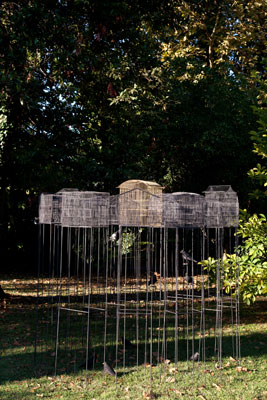
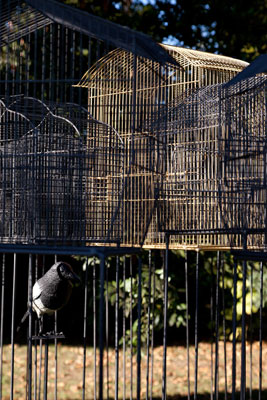
Marco Pellizzola has been active for years with interventions focussed on the territory in a field of application that ranges from schools to public parks and urban walkways in various towns in Italy and abroad. Consistent with his previous research which has already considered cages, he confirms the same original subject on this occasion. The open-air installation of cages in the striking setting of the park on the Island of San Servolo - also known in the lagoon as the madmen's island because for many years it was sadly famous as the home of the psychiatric hospital - aims to express the relationship between natural and artificial, between reality and fiction, in which art has always struggled at every latitude: the cage as a symbol of closure and imprisonment, taken out of its context in this case by the artist using intentionally misleading terms, becomes a place of rest, perches for birds that are also attracted by their fellows, but they are artificial ones, placed outside the cages, decoy birds no longer used for capturing or hunting the real ones, with which they now live in harmony in pleasant natural surroundings.
In this sense artifice and nature resume their most harmonious and immediate relationship as it was in classical western art, just as occurs in other cultures, different from our own, and as seems still to be the necessary basis in the contemporary world.
Text by Saverio Simi de Burgis
ITALY - MICHELA PEDRON
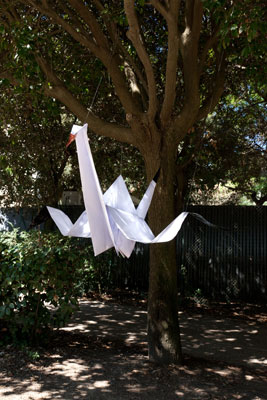
On the wings of the oritsuru
According to an old Japanese legend, anyone who can fold at least one thousand paper cranes, using the origami technique, will have all his dearest wishes and prayers come true.
When visiting the Shinto temples scattered all over Japan, it is not uncommon to see garlands of coloured cranes, skilfully made out of sheets of paper, shaken by the wind at the gates of the temple, making a sound like a whispered prayer.
The crane is traditionally associated with the concept of long life and dedication, it is substantially an apotropaic figure, of fundamental importance in the Shinto world.
One of the most touching episodes of post-war Japanese history is also linked to the myth of the thousand cranes: it is the story of Sadako Sasami, a girl who was two years old in 1945 and lived in Hiroshima, just about a kilometre from the spot where the bomb fell, and she was miraculously unharmed. She grew up, but the bomb had not stopped killing: in February 1955, at the age of twelve, Sadako fell ill with leukaemia caused by the effects of the radiations.
Sadako spent the long days in hospital making little origami cranes. She died on the morning of 25 October 1955. Since that day thousands and thousands of paper cranes, of all sizes and all colours, have been made continuously by all the children and inhabitants of Hiroshima and turned into garlands, patterns and compositions of all kinds that are used instead of flowers to decorate memorial sites: countless numbers of little cranes are also sent to the city of Hiroshima from all over the world.
That’s why the origami motif of the crane has been chosen as a symbol of peace and brotherhood for all peoples in the world.
All these suggestions are summed up in the large installation entitled Big Oritsuru - the Japanese name for the crane - by the young artist Michela Pedron.
In her vision, not one thousand cranes but a crane one thousand times bigger, bearing on its beak an indelible sign, the blood of the artist, and which assumes a profoundly sacred meaning, confirming its role as a bridge between east and west.
The work before us presents clear aspects of cultural hybridisation, the reference to the Shinto myth of the crane blends with the idea, present in Christian doctrine but taken from an anthropological tradition common not only to the Mediterranean cultures but to the whole human race, according to which blood is the most effective sacrificial offering.
The action of cultural mediation is achieved by metaphorically renouncing the gory aspect associated with the allegorical meanings of blood, and combining it, not only physically, with the figure of the crane, a symbol of life and hope, which falls within the Tao concept of harmony. But the crane, bearing on its beak the tangible and physical sign of the artist’s presence - her offering - also becomes an intermediary for reaching the divinity and, at the same time, implies a message of change.
Text by Igor Zanti
ITALY - MARGHERITA MAURO
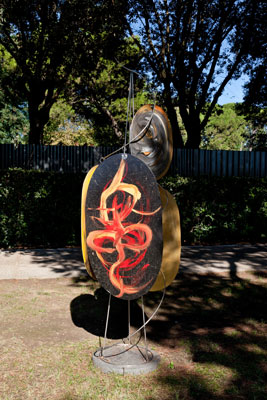
Margherita Mauro sees sculpture as a passion, a stimulus, an urge to translate emotions. She didn’t go to art school or have any teachers. Her painting springs from an inborn talent, from an inner need that she cannot escape and that goes step by step with the art of music.
Right from her earliest works in charcoal and coloured chalks, she has shown a predisposition for a decisive stroke that generates the incisive outlines of forms, enveloping her works in a metaphysical immobility. Her research is also based on painting material which is not only a means of expression but is itself a sensitive substance that captures duration and extension. Her works are manipulated at different stages with delicate or harsh gestures to soak the support in colours, now soft, now intense, so as to communicate the alternate rhythm of hope and anxiety of our times. Emotions are supplied by the chromatic effect, made of colours consumed by secondary interventions and definite outlines, but with such a softness that they strikingly alter the figure in the dream dimension.
It is this sincerity of expression, this prevalence of music without notes and words without text as opposed to the prose-like and immodest use of the voice, that gives even more value to the artist’s work. She sketches figures that emerge as primeval traces from the surface, to suggest and not reveal. Her informal use of gesture accompanies freely inspired accents in which the hybrid aspect of organic matter becomes real and human at the same time, living and speaking matter. Sometimes she contorts the form into extreme metamorphoses, charging the surface to which she gives the right atmosphere each time by resorting to a mobility of different rhythms, timbres and colours, so that the shapes vary from curvilinear impetuosity to harshly cut hollows, sometimes more graphic than pictorial.
Spatial research and melodic chromatic intonation are the outstanding elements of this painting, suspended between dream and a reality made of a transformation that becomes modern poetry, the charm of a look at nature, at the world that surrounds us to give us magic emotions. This extreme fluidity of forms and colours determines, by osmosis, a chromatic and spatial mobility, so that not only does the colour appear to change, but the image varies constantly too, with semantic friction.
The installation that the artist presents at OPEN offers a new realisation and different modulation of the fundamental characteristics of her painting. Here each aspect - form, matter and colour - is the echo of an ancient, arcane symbolism, shared and stored away, which creates new original metaphors and syntheses in a game of balances and references: from the historical, philosophical and mathematical implications of the circle, the pyramid and the spiral to the symbolism of gold, blue, black and brown, to the dialectic encounter of stone and steel. Solidified and stratified meanings generate new ones when they meet, in confrontation and interaction, leading to original new interpretations that the artist calls a journey. A journey in the double significance of space and time, a path to be followed, a dynamic relationship with others, comparison and research, a continuous creation of inexhaustible meanings.
Text by Paolo De Grandis